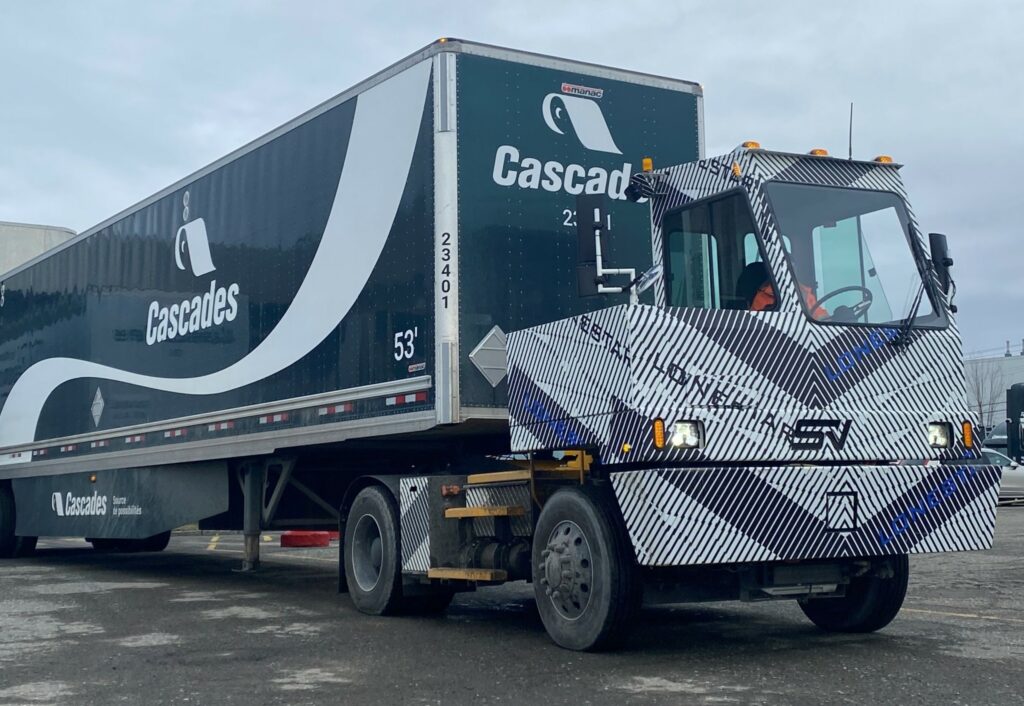Cascades, PIT Group testing electric shunt truck
The perfect vehicle for making an electric shift may be in the backyards of trucking companies and distribution centers. Shunt trucks run in a closed loop and their operations are repetitive. There is less range anxiety because they are always near a charging station.
Recognizing this, Cascades Transport and members of the PIT Group wanted to learn more about the operational and environmental potential of electric shunt trucks, especially in winter conditions.
“The question that always comes up with electric vehicles is how will they perform in Canada in winter? That’s what we wanted to demystify with these trials at Cascades,” says Marc Trudeau, business development manager of FPInnovations’ PIT Group.
Yan Lambert, director of operations for Cascades Transport, has long been interested in the possibility of electrifying his shunt trucks. He immediately expressed his interest to the PIT Group when he learned that such a project was being prepared for its members.
After several months of approaching manufacturers, Texas-based LonesStar SV agreed to participate in the project with its Lonestar S22 shunt truck. The vehicle, equipped with a Dana powertrain, finally found its way to the Cascades plant in Kingsey Falls, Que., to undergo a battery of tests developed and supervised by the PIT Group.

Sustainable development is part of Cascades’ DNA, the company says, and participating in these tests is a natural progression. The company has practically created an electric village in Kingsey Falls, offering financial assistance to employees who acquire an electric car. And it’s no coincidence that no less than 48 charging stations are already installed in this municipality of 2,000 people. Cascades has already converted 90% of its forklift fleet from propane to electricity.
“With the knowledge we’ve gained from this transition, using electric yard tractors makes sense. The truck runs around the charging station. We see this as a good opportunity,” says Lambert.
The LoneStar yard tractor that was tested from February to April is a prototype that was prepared at Dana’s Technology Centre in Laval. It is equipped with a TM4 Sumo engine and two 110 kWh batteries. Cascades operates six shunt tractors driven by 12 operators on several shifts. Various operators drove the tractors during the trials. The sensors and telemetry systems installed on the vehicle will allow for the collection of a wide range of data, including range, recharging and heating system usage.
The vehicle is a six-wheel tractor with an 80,000-lb. capacity, but the manufacturer has invited Cascades to move three- or four-axle trailers weighing more than 100,000 lb. if they wish.
“We’ve tested it and the tractor does the job, but the speed is reduced and it puts a lot of demand on the batteries,” says Lambert.
“From a safety standpoint, we want to make sure that everything is well suited for winter conditions, such as the wheels not spinning when the vehicle is moving without a load. The programming of the electric vehicles is changeable, so it will be reviewed as needed,” adds Marc Trudeau. “In addition, we want to make comparisons with the diesel trucks used here to evaluate the reduction in polluting emissions.”
PIT Group also wants to evaluate maintenance costs compared to diesel, although this will be difficult given that the tests only lasted two months. However, it will be possible to project the total operating cost with the data collected.
The human factor is also important. PIT Group will evaluate the benefits of electric propulsion on operators, such as the absence of diesel engine noise and odors and the substantial reduction in cabin vibration.
One operator we spoke to on site said the electric Lonestar is “very pleasant to drive and really quiet,” and he wouldn’t mind switching from a diesel-powered yard tractor to an electric model, with a few improvements, such as visibility on the right side and steps to get into the cab.
“We are very aware that this is a prototype built for research. We wanted to see if this shunter could do the job,” says Lambert.
LoneStar claims that its dual-battery shunter can work up to 22 hours a day under normal conditions. This is an impressive technological advancement. It remains to be seen how it will perform in the worst of winter working conditions.
Have your say
This is a moderated forum. Comments will no longer be published unless they are accompanied by a first and last name and a verifiable email address. (Today's Trucking will not publish or share the email address.) Profane language and content deemed to be libelous, racist, or threatening in nature will not be published under any circumstances.
NO COMMENTS ON THE % OF REDUCTION OF CAPACITY OF BATTERY AND POWER VERSUS WHAT IS NORMAL IN COLD WEATHER .
PROTOTYPE.
INCOMPLETE NO WEATHER REPORT,
VARIOUS DEGREES OF WEATHER
UNKKOWN DAY OR NITE…..